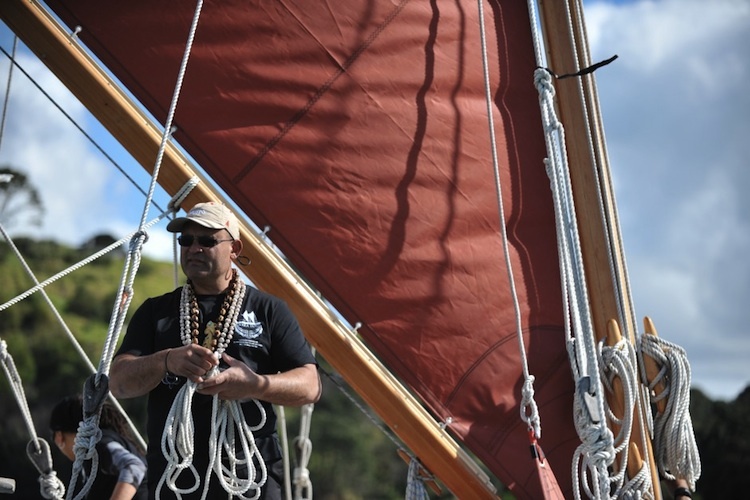Navigator Jack Thatcher commanded the two waka hourua that sailed from Aotearoa (New Zealand) to Rapanui (Easter Island) and back. Te Aurere and its supporting vessel Ngahiraka Mai Tawhiti, known collectively as the Waka Tapu, set sail from Auckland on 17 August 2012.
They sailed to Rapanui via Tubuai and Mangareva and then returned via Moorea and Rarotonga to arrive back in Doubtless Bay (in the Far North) 9 months later on 15 May 2013 – completing a journey of over 10,000 nautical miles (18,500 km).
The crew of the two waka navigated without instruments. They used celestial navigation to guide them. They relied on the stars, Sun, Moon, ocean swells and currents, bird and sea life rather than modern technology such as GPS.
The Polynesian triangle
The goal of the journey was to close the Polynesian triangle. Some 3000 years ago, explorers, probably from South-East Asia, moved eastwards across the Pacific. Many settled in what is now known as Polynesia. These now diverse societies form the Polynesian triangle – with Hawaii in the north, Rapanui in the east and Aotearoa (New Zealand) in the south-west. The waka Te Aurere had already been to central Polynesia and north to Hawaii, but it was this voyage that completed the journey to the east – a journey many had suggested was an impossible task.
Confirming ancient voyaging
The journeys confirm that it is possible to successfully and deliberately travel great distances (and in any direction) by canoe without using navigational instruments. Ancient Polynesians could have purposefully navigated in a similar way in double-hulled canoes to find new lands, including Aotearoa. It is believed that waka left Rarotonga over 800 years ago in search of Aotearoa. Most Māori iwi trace their origin back to these waka.
Jack explains that going to Rapanui was quite a conquest. Although it is agreed that Māori ancestors brought kūmara back from the Americas, there are many theories about whether they navigated there and back intentionally. Most theorists believed the windward, eastern voyage towards the Americas was an impossible task, so Jack’s accomplishment helped to change people’s minds. Jack says,
There are times seasonally when this journey can be done easily. We found a way, and this suggests that our ancestors knew this way also.
Reconnecting
The Polynesian societies all share a common origin. The goal of the Waka Tapu voyage was to reconnect with the people of Polynesia, and the culmination of this reconnection was to reach the east end – Rapanui. In the end, Jack and the crew found that the actual reconnecting with the people of Polynesia was the most important part of the journey. They spent hours sharing stories about common ancestors. They found that the various Polynesian cultures had a lot in common that went beyond similarities in language. Jack talks about a strong sense of belonging that made the voyage “a very right thing to do”.
Other research
During the expedition, Jack made careful observations of celestial bodies, particularly the Sun. He is working to refine navigational strategies for keeping direction during the day when the Sun is not so reliable for that.
The crew also collected research data for scientists. For instance, they collected information about ocean water temperatures for the Cawthron Institute.
Funding
The journey was a collaboration between two New Zealand groups – New Zealand Māori Arts and Crafts Institute and Te Tai Tokerau Tarai Waka. The New Zealand Māori Arts and Crafts Institute in Rotorua focuses on guarding and teaching traditional Māori arts and crafts, and Te Tai Tokerau Tarai Waka teaches traditional sailing and navigation methods in Doubtless Bay in the Far North.
Tāwera, Te Aramahiti
Survival, rediscovery, and the restoration of pride and dignity is echoed in the story of the re-emergence of traditional navigation and voyaging right across Polynesia.
Jack Thatcher and Jeff Evans
This theme underpins the article Tāwera, Te Aramahiti – The Morning Star Guides Eastward: Reviving Traditional Navigation Knowledge in the Pacific (PDF, 5.74 MB). The article provides extensive background information regarding early Pacific navigation. It also revitalises kōrero with the stories of Tāwhaki, Tāne, Māui, Kupe, Kuramārōtini and Rata. The article features knowledge contributed by Master Navigator, Jack Thatcher and was written by Jeff Evans. It was commissioned by the New Zealand Commission for UNESCO.
Related content
Explore our other resources on navigating without instruments, these includes the activities below.
Related student activities involve legends, compass skills and cloud observation:
- Constellations in the night sky looks at star legends from cultures around the world.
- Kupe and modern voyaging uses the legend of Kupe to compare ancient and modern navigation techniques.
- How’s your memory? involves the memorisation of the star compass components – just like the real navigators.
- Navigating by the stars introduces students to traditional navigational skills – using the cardinal directions and the Southern Cross.
- Compass treasure hunt uses knowledge of the Sun and Moon to make compass directions and uses these directions in a treasure hunt.
- Clouds and the weather observes cloud types and how they help predict the weather.
Useful link
Read the story of the Hōkūle’a and the beginnings of the wayfinding voyages of rediscovery. Explore the site for voyage tracking maps, learning journeys, videos, teaching activities and more related to the art and science of Polynesian voyaging.



